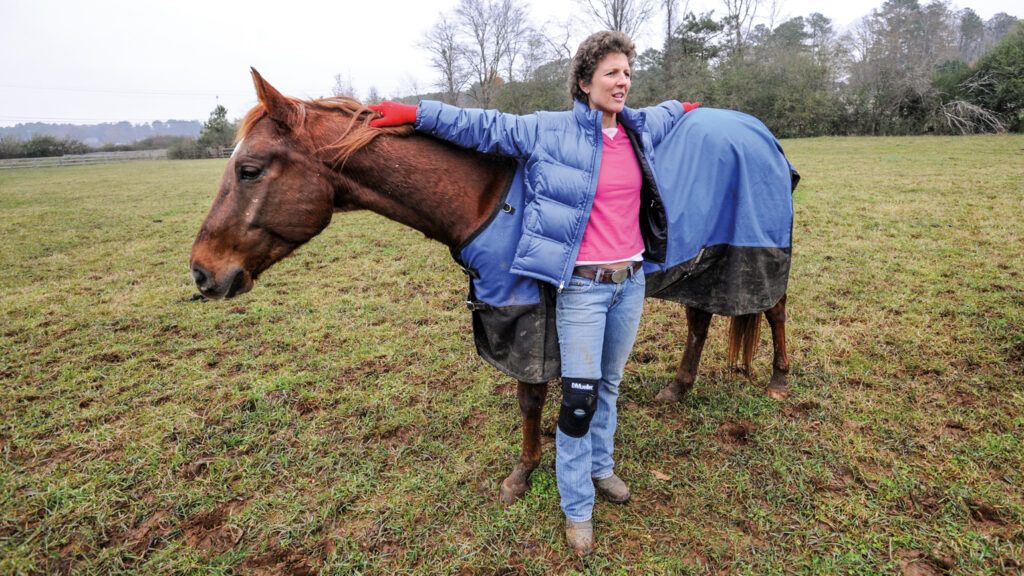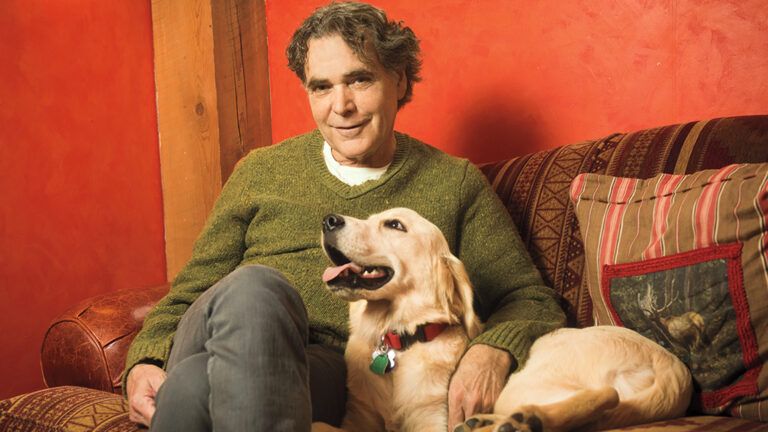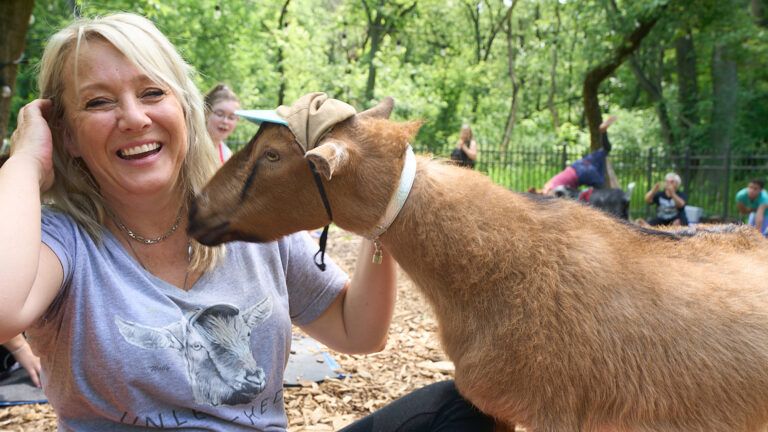If you know even a little about soccer, you know the name Michelle Akers. She led the U.S. women’s national team to two FIFA World Cup championships and an Olympic gold medal and scored 105 goals in international competition, despite having more than 20 surgeries and playing three positions over the course of her 15-year career. Widely regarded as the best woman ever to play the game, Akers retired from soccer in 2000, having left her mark on the field.
Now the only muddy grass she’s stepping onto is at The Farm, her sanctuary for abused and unwanted horses and other animals in Powder Springs, Georgia. Keeping the rescue going has been a bigger challenge than any soccer match, but she has no plans to retire from this gig.
Have you always loved horses?
Growing up, I wanted to be like Alec in The Black Stallion. I imagined having my own black stallion to race off into the wild blue yonder with. It was my dream to have my own herd of horses. I’m not quite there yet, but I’m working on it.
How did you start rescuing animals?
I knew that after I retired from soccer I wanted to transition into horses and being a cowgirl. By 2007 I already had four horses, three dogs and two cats on my farm in Orlando. One day animal control and the police rescued an abused horse near my neighborhood, and I visited her in her foster home. I saw a sign-up sheet for animal control volunteers and added my name to it with the intention of helping with transport. The very next morning someone called and asked if I would pick up and foster a horse from a recent abuse case.
What was it like to rescue her?
I didn’t know if I could do it at first—face this broken horse every day. It hurts my heart to see animals suffer, but ultimately I decided I had to at least try. I thought, I’ll just do my best and see how it goes. Her name was Zoe, and she had been starved and was in horrible condition when I went to pick her up. I think she had been trapped in barbed wire. I drove her home and led her to my barn to meet the other horses. She saw them and let out a deep breath, like she could finally relax. I knew immediately I’d made the right decision.
And you nursed her back to health?
I did. I called four or five horse rescues and learned their strategies to re-feed a severely starved horse. You can’t just start feeding full portions right away, so I gave her tiny fistfuls of food every hour or so for 48 hours. I followed the advice of other animal rescuers, and although it was full of challenges, slowly she got better. It took two years. Initially, my goal was to put her up for adoption, but I decided to keep her in the end, because she had significant health issues and was so old—over 20 years, at least. It would have been difficult to re-home her. Zoe was so weak and couldn’t be with my other horses, so I adopted four pygmy goats to keep her company. They were inseparable. The goats often stood underneath her for shade and slept in her stall.
How did you get your official horse and animal rescue off the ground?
I did my own paperwork to form a public charity in 2007. I figured I could get the soccer community and horse lovers to pitch in. I fund the rescue through individual donations, grants and sometimes soccer camps, clinics and personal appearances. I also sell Akers U.S. #10 replica jerseys and other items from my playing days. It costs about $700 a month to take care of a healthy horse, so donations and creating other revenue sources are always on my mind.
What are some of the challenges of running The Farm?
When I first got started, Morgan Silver of the Horse Rescue Association of Florida actually advised me against it. She said horse rescue was extremely challenging, and she was right. It’s difficult to raise money. There are so many animals that need help, and space is limited—I have eight acres. It’s a lot of work: The horses need to be fed, watered, taken care of and cleaned up after. I can’t wake up one morning and decide to sleep in. Equipment is always breaking or needs to be replaced. The weather is either too hot, too cold, too rainy or too dry. But despite that, I love it, and the work is worth it when I see how these animals are thriving.
What does The Farm do for community outreach?
I try to educate the public about horses and animals and the need to support rescues and adopt from animal shelters. I also try to inspire and support community service for farms, animal welfare organizations and animal owners in need by providing a network of horse-and animal-friendly people and organizations.
What kinds of horses do you usually take in?
Most rescues go after animals that are on the edge of death—the ones who will die immediately without intervention. But nobody seems to go for the in-betweeners. These are the animals that won’t necessarily die in two weeks, but that could be dead in six months if their situation continues, if they are sent to auction or if a kill buyer gets a hold of them. There are so many horses who need help. It’s often overwhelming, and since I have limited space and resources, I spend lots of time networking with other rescues in an effort to help each horse.
What’s a typical day for you?
No two days are alike, but I always wake up and feed the horses in the early morning and again at three in the afternoon. Between feedings, I clean the barn and the stalls and tend to little things like fixing a fence or putting up a gate. I mow the pastures, weed-whack, buy and stack hay. I take care of Cody, my 14-year-old son. Sometimes I get a call from someone asking me to take in a horse, so I work with them to get the animal settled, if not with me, then somewhere else. There are never enough hours in the day to get everything done!
Are there any lessons from your soccer career that influence your work at The Farm?
I’ve learned that you have to be flexible. Rarely do things go according to plan—on the field or at The Farm. It’s those detours that teach you something about your end goal. I’ve also realized that when you do work like this, sports become less of a big deal. If I missed a day of training as a soccer player, it wouldn’t have been an issue, but if I don’t care for my buddies in the barn, it matters. It’s life or death. My perspective on what’s important has changed.
Do any injuries or health issues from your playing days still affect you?
In my life, I’ve had over 30 surgeries, so my body is kind of a wreck. I still get migraines sometimes, but overall I feel better. Lots of sleep, a good diet and staying hydrated is key for me. Nothing will stop me from working all day long and taking care of everybody.
You’ve always had strong faith. How has The Farm changed your relationship with God?
It’s broadened my idea of spiritual connectedness. Horses in a herd are connected. So are humans. When one horse reacts to something in a field, the others feel it. I’ve seen it happen. I believe we’re all—God, heaven, animals—connected like that. I know that when I lose a horse, it’s still with me and remains connected spiritually and energetically.
How can people support The Farm?
Donate, please! They can contribute on my website. It’s always humbling to get a donation, and it’s the most effective way to help. Every penny we receive goes toward taking care of horses and other animals, allowing them to live the best life possible.
Did you enjoy this story? Subscribe to All Creatures magazine.





